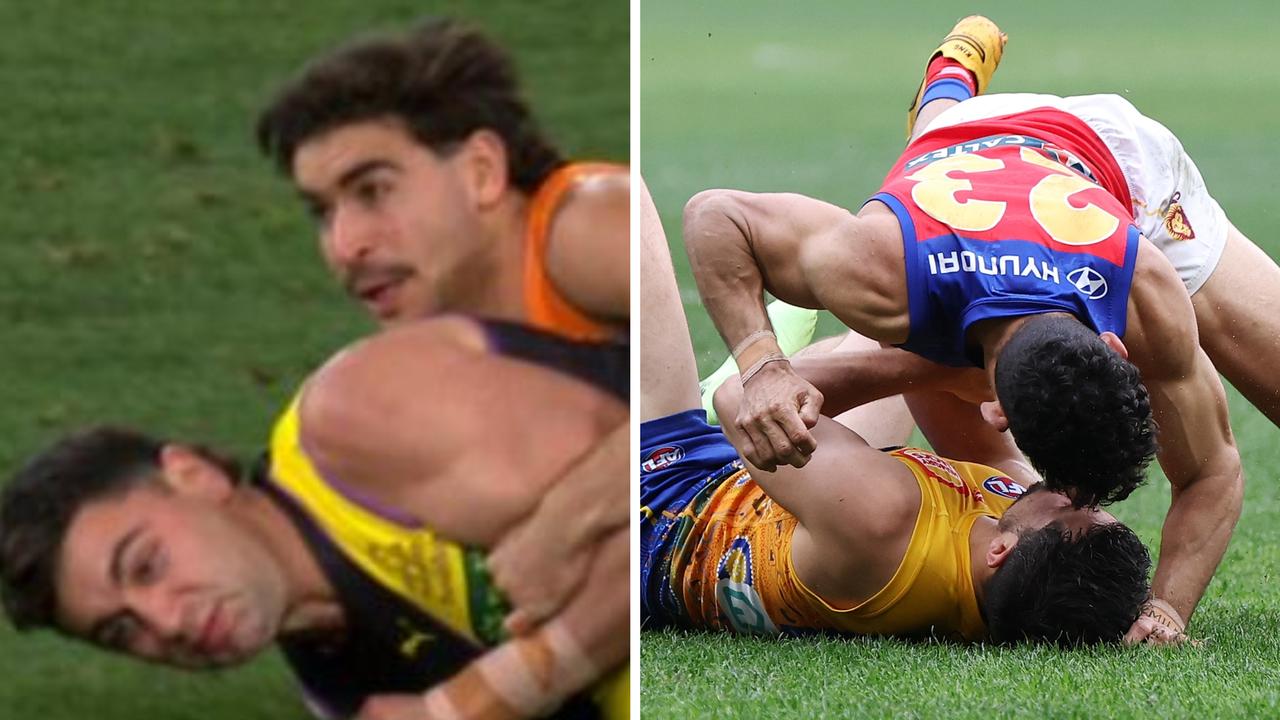AFL’s ‘error of law’ hands Lions shock appeal WIN in first dangerous tackle case — LIVE

- by Admin
- July 18, 2024

One dangerous tackle ban has already been overturned at the AFL Appeals Board in a bombshell result, with another fight to come. Live below!
Brisbane successfully freed star forward Charlie Cameron of his three-game suspension in a bombshell ruling on Thursday evening.
The Lions argued the Tribunal, chaired by Renee Enbom, made an error of law by focusing on the specifics of the rough conduct guidelines, rather than the rules of the game and whether Cameron’s tackle on Liam Duggan was rough conduct in the first place.
Watch every game of every round this Toyota AFL Premiership Season LIVE with no ad-breaks during play on Kayo. New to Kayo? Start your free trial today >
They also said the decision was so unreasonable no Tribunal acting reasonably could’ve made it.
The Appeals Board agreed with Brisbane’s first argument and said the rules state for it to be rough conduct, the conduct must be likely to cause injury – which the Tribunal “was silent upon”.
The ruling is arguably just on legal grounds, because the Tribunal did not explain its case well enough, rather than clearing up which types of tackles are legal and which are not – though future Tribunals should need to consider the whether the action is likely to cause injury before declaring a tackle as rough conduct in the first place.
The Giants are hoping to find similar success with Toby Bedford’s dangerous tackle ban, which came after he concussed Richmond’s Tim Taranto.
‘Tackle is going the way of the bump’ | 00:37
CAMERON HEARING
Representing Brisbane, Chris Winneke KC said there were two grounds for the appeal:
– With their reliance on the Tribunal guidelines in preference to the laws of the game, Tribunal impermissibly prioritised the guidelines over the laws. The path of reasoning thus created a material error of law;
– The factual findings and conclusion of rough conduct were so unreasonable that no reasonable Tribunal could’ve reached the same findings and conclusion.
The Lions argued the Tribunal focused on how the rough conduct guidelines impact the offence, rather than first finding whether the tackle was a reportable offence, and “in effect put the cart before the horse”.
“The Tribunal applied the text of the guidelines as if they had legal force, which we say is an error of law … the guidelines are directory only,” Winneke said.
Appeal chairman Will Houghton KC asked what material effect this had on the Tribunal’s decision-making, with Winneke pointing to the rules which state the consideration of rough conduct must include “whether the conduct was likely to cause injury”.
“We say this tackle, the approach to the tackle and the actual tackle itself was a lawful tackle,” Winneke said.
“It’s not contact between members of the public in a supermarket. It’s between strong, fit people playing on a football field in a contact sport.”
The Lions also argued it was “fanciful” to suggest Cameron could’ve tried to sit Liam Duggan down in their tackle.
“This is a great game, Australian football, because it’s an incredibly skilled game with incredibly skilled players, who engage in conduct which by definition and requirement requires body-on-body contact,” Winneke said.
“There’ll be circumstances where players will suffer injury despite players exercising reasonable care. To find that Cameron did not exercise reasonable care was simply not open on the evidence.”
Lisa Hannon for the AFL said there was no error of law and the Appeals Board should ignore the suggestion the Tribunal only listened to the guidelines over the rules; and that even if the Tribunal did that, their approach would’ve been “no different” had it behaved differently.
Appeal chairman Houghton questioned the AFL’s case, that the Tribunal had considered the rules of the game and not just the guidelines, based on the Tribunal not mentioning the rules within its stated reasoning.
Hannon argued the guidelines are not inconsistent with the laws of the game, and the fact there was an injury points to the incident being likely to cause injury, but it’s not determinative.
Tribunal reasons
The decision of the Tribunal really revolved around the AFL Tribunal guidelines.
It had particular emphasis on guideline 4.3(E) Rough Conduct and subrule three of that guideline dealt with dangerous tackles and described rough conduct as being unreasonable in the circumstances.
There were four factors which the guidelines recommended the Tribunal to look at.
One of the factors was whether or not the tackled player was left in a vulnerable position, and the second factor taken into account by the Tribunal was whether Cameron had slung, driven or rotated his opponent into the ground with excessive force.
The Tribunal made a finding that the conduct of Cameron was unreasonable in the circumstances.
However, what the Tribunal did not do was deal with the elements of the charge which is set out in the laws of Australian Football. In particular, what the Tribunal did not deal with was Law 18.7, which is entitled ‘Rough Conduct’.
That rule provides as follows, 18.7.1, spirit and intention, players should be protected from unreasonable conduct from an opposition player which is likely to cause injury.
We accept that the Tribunal below found the conduct to be unreasonable, which is one element of the offence, but it completely failed to consider the second critical element of the offence, that is whether the conduct was likely to cause injury.
Absent that consideration and absent any reference to law 18.7, we consider that the Tribunal below fell into an error of law that had a material impact on its decision.
Unless and until the Tribunal had material upon which it could make a finding that the conduct of Cameron was likely to cause injury, it could not find that Cameron had committed any offence.
And in a sense, we were assisted by the video, because we of course, read the transcript and looked closely at the video.
It couldn’t be said by any member of this board that it leads us to the conclusion the conduct of Cameron was likely to cause injury.
It would have been a matter that would be open to a Tribunal to make that finding or not. But in this case, made no such finding.
It was not referred to law 18.7 and it made no reference in its reasons to the existence of law 18.7 or the two elements, the two important elements which needed to be established to establish the guilt of Cameron – the charge of rough conduct.
We’ve dealt in the past with the guidelines; we’ve said in the past that the guidelines give assistance to the Tribunal below, its chairperson, and the players and the clubs, but reliance wholly solely upon the guidelines was another error that we perceive the Tribunal fell into.
Whether or not it had any material effect, is another question that we don’t need to determine in light of the reasons we’ve given above.
But it’s important the laws of Australian football have primacy over the guidelines if there is any contradiction or inconsistency. And here law 18.7 very clearly states, not only must the conduct be unreasonable, but the conduct must be found to be likely to cause injury, and it’s that second element that the Tribunal was completely silent upon.
Accordingly, it’s not necessary for us to go on and determine the reasonableness ground of appeal, it’s not necessary for us to do so, and we don’t descend into adjudicating upon that second ground of appeal.
So for the reasons we’ve given above, the appeal by Cameron is allowed, and the order of the appeal board is that the charge put against Cameron before the Tribunal and on appeal to this appeal board is dismissed.
BEDFORD HEARING
Anais d’Arville for the Giants argued Bedford’s tackle was not careless conduct within the meaning of the Tribunal guidelines, also taking issue with the grading of impact.
They also took issue with what the AFL said Bedford could’ve done instead of tackling in the way he did.
“There was no suggestion of tackling in a way that was different from leaping. For that reason, the finding amounts to a rejection of the first case theory of the AFL that there was an alternative way of tackling,” d’Arvillle said.
Chairman Will Houghton argued d’Arville was “relitigating” the case made at the Tribunal.
D’Arville said the AFL’s counter-argument of what Bedford should’ve done took place would’ve taken place in less than two seconds.
He argued the AFL’s counter-argument “goes beyond any athletes’ cognitive and physical limits. It’s simply too much to ask of an athlete in the position of Mr Bedford.”
The Giants said more evidence was needed to suggest a player could actually do the alternative actions and even the experts available at the Tribunal couldn’t make that finding.
They argued an error of law came from making a factual finding without any evidence to support that finding, but the chair countered they had the video and listened to Bedford’s evidence.
The Giants say it was a denial of procedural fairness to base its decision on an assertion about medical evidence (that all reportable incidents resulting in concussion are ‘severe’ impact), which was not put to Bedford and was an error of law.
The chair was not convinced by that argument.
The AFL, represented by Lisa Hannon, argued the Tribunal was within its rights to make its ruling on what Bedford could have alternatively done and the video evidence allowed it to make this decision.
Follow live updates from the AFL Appeals Board below!
The Latest News
-
November 24, 2024Andy Murray coaching Novak Djokovic: What it could mean for friends and rivals
-
November 24, 2024Maxwell wary of ‘risk’ in bid to end seven-year exile
-
November 24, 2024Australia’s Highest Chases, Full List: How Many Do India Need To Be Safe? | AUS v IND 2024/25 | Cricket News Today
-
November 24, 2024‘Next generational batting talent’: Starc sledge, Marnus tease that proved India has a new superstar
-
November 24, 2024Lee sees upside despite ‘freak’ injury in PGA defence


